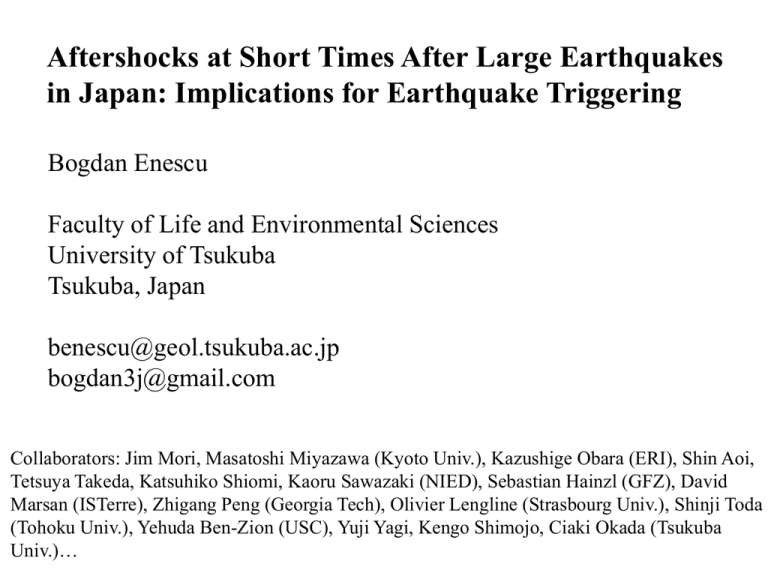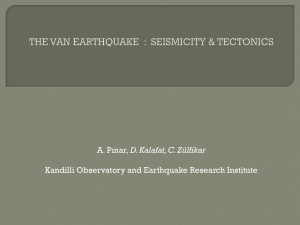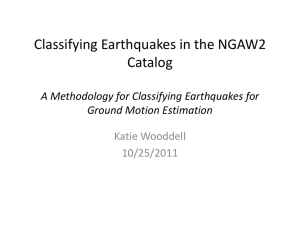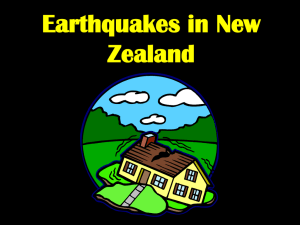Aftershocks at short times after large earthquakes in Japan
advertisement

Aftershocks at Short Times After Large Earthquakes in Japan: Implications for Earthquake Triggering Bogdan Enescu Faculty of Life and Environmental Sciences University of Tsukuba Tsukuba, Japan benescu@geol.tsukuba.ac.jp bogdan3j@gmail.com Collaborators: Jim Mori, Masatoshi Miyazawa (Kyoto Univ.), Kazushige Obara (ERI), Shin Aoi, Tetsuya Takeda, Katsuhiko Shiomi, Kaoru Sawazaki (NIED), Sebastian Hainzl (GFZ), David Marsan (ISTerre), Zhigang Peng (Georgia Tech), Olivier Lengline (Strasbourg Univ.), Shinji Toda (Tohoku Univ.), Yehuda Ben-Zion (USC), Yuji Yagi, Kengo Shimojo, Ciaki Okada (Tsukuba Univ.)… Early aftershocks – Time and Space Main topics: 1) Temporal features: - How the aftershocks rate decay immediately after the mainshock? - time domain; - energy domain; - What this decay tells us about the aftershocks occurrence mechanism (rate-and-state friction law modeling)? 2) Spatial features: - Migrations (indicating correlations with afterslip)? - Correlations with the arrival of mainshock surface waves for remotely triggered events after Tohoku-oki earthquake (more than 1300 km from the mainshock)? - Possible role of fluids in the activation of seismicity? Early aftershocks - Time Early aftershocks Hi-net (防災科学技術研究所高感度地震観測網) Log (Rate) Early aftershocks - Time p ~ 1.0 c-value (min. – 1day) (deviation from power-law) Empirical law Omori-Utsu law (Utsu, 1961): n(t) = K/(t+c)p, n(t) - earthquake rate, K, c, p - constants 大森房吉先生 (1868 – 1923) Physics-based law Mainshock Log (Time) Aftershock rate versus time THE RATE AND STATE DEPENDENT FRICTION LAW PREDICTS DEVIATION FROM THE (POWERLAW) OMORI LAW. Early aftershocks - Time THE BEGINNING OF AN AFTERSHOCK SEQUENCE : 1) c-value typically ranges from 0.5 to 20 hours (Utsu et. al., 1995); 2) Kagan (2004): INCOMPLETENESS prohibits assessing early aftershocks from catalogs, but probably c-value (of the Omori-Utsu law) is 0; 3) c-value is LARGER THAN 0 and depends on the MINIMUM MAGNITUDE (Shcherbakov et al., 2004; Nanjo et al., 2007); 4) Peng et al. (2006, 2007) and Enescu et al. (2007, 2009): cvalues of less than A FEW MINUTES from the study of high- resolution waveform data from Japan and US; Early aftershocks - Time Two main techniques are used to detect earthquakes “hidden” within the noisy waveforms: 1) Simply quantifying (counting + magnitude determination) the seismic events revealed by high-pass filtering of seismic waveforms [e.g., Peng et al., 2007; Enescu et al., 2007; Marsan and Enescu , 2012]. No location available. Sometimes the envelopes are used instead of the high-pass filtered waveforms. 2) A second technique is based on the correlation of the continuous seismic signal with pre-determined template events. This technique has been initially applied to detect low frequency earthquakes (LFE) [Shelly et al., 2007]. It has also been proven successful in recovering missing earthquakes during aftershock [Peng & Zhao, 2009; Enescu et al., 2010; Kato et al., 2012; Lengline et al., 2012], foreshock [Bouchon et al., 2011] and remotely triggered earthquake sequences [Meng et al., 2012]. Early aftershocks - Time Large events: Mainshock: M6.8: 10/23, 17:56 Aftershocks: M6.3, 18:03 M6.0: 18:11 M6.5: 18:34 M6.1: 10/27, 10:40 Enescu, Mori, Miyazawa, JGR, 2007 Data processing: 1. High-pass filter the waveform data to detect small events hidden in the low-frequency coda. 2. The magnitude is calibrated using a set of events that are both detected on seismograms and listed in the JMA catalog. 3. Combine the waveform based catalog with the JMA catalog. 4. Analyse the aftershock decay of the combined catalog (Omori-Utsu law + maximum likelihood method, Ogata, 1983). Early aftershocks - Time 5Hz high-pass filtered NGOH station Enescu et al., JGR, 2007 Early aftershocks - Time c-value ~ 4 minutes p = 1.13+/-0.02 K = 33.83+/-2.01 c = 0.003+/-0.001 ? M 3.4 There are fewer aftershocks than predicted by the Omori law in the first 0.003 days after the mainshock. Time decay of the number of aftershocks, picked from seismograms at Ngoh (o), Ynth stations (x) and JMA (+). Enescu et al., JGR, 2007 Early aftershocks - Time Non-linear least-square inversion: r R(t , ) (e ( ) A 1)e t ta 1 r = 0.0052 events/day Unknowns: ta and /A M 3.4 Rate-state friction law (Dieterich, 1994) modeling Enescu et al., JGR, 2007 Early aftershocks - Time M 3.5 2000 Tottori 2005 Fukuoka c-value ~ less than a few minutes 2007 Noto 2007 Chuetsu-oki Enescu et al., BSSA, 2009 Working in the energy domain Synthesis of seismic wave envelope Incoherent propagation of highfreq. seismic waves Envelope E W PS Site amplification (S) Energy Radiation(W) Energy Propagation (P) Sawazaki and Enescu, JGR, 2013 Energy propagation process P R, f , t exp g 0 f V0 2Q 1 f f t R t V 4VS R 2 S 2 18 1 R 2 VS t exp g 0 f VS 2Q 1 f f t 32 4VS t 3g 0 f 34 R2 R M g 0 f V0t 1 2 2 H t VS t VS M x expx 1 2.026 x ●:Scatterer →:Energy path Nakahara et al. (1998) Sawazaki and Enescu, JGR, 2013 R: Source distance VS=3.5km/s (fixed) g0( f ): scattering coefficient Q-1( f ): inverse intrinsic Q-factor To account for the multiple scattering of S wave energy for a point-like impulsive source, we use the equation proposed by Paasschens [1997] as the envelope Green’s function P. Synthesized envelope Sawazaki and Enescu, JGR, 2013 Energy release rate W t K tp Energy radiation function shows a slope of 1.6 for times larger than ~ 40s. Sawazaki and Enescu, JGR, 2013 Early aftershocks - Time Why c-values are very small? According to the rate-and-state friction law: 𝐾 n t = 𝑡+𝑐 K= 𝐴𝜎 𝑟 𝜏 𝐴𝜎 −∆𝐶𝐹𝑆 c= exp 𝜏 𝐴𝜎 n(t) – aftershock frequency K – productivity c – delay-time A – dimensionless fault constant parameter σ – normal stress – tectonic stressing rate Large values of stress change result in small c-values: high stress heterogeneity can explain small c-values Early aftershocks - Space Decay and expansion of the early aftershock activity, following the 2011, Mw9.0 Tohoku earthquake NE SW Lengline, Enescu, Peng & Shiomi, GRL, 2012 Distribution of Hi-net catalog aftershocks occurred in the first eight days from the Tohoku-oki mainshock (red circles), slip (colored) and afterslip distribution (Ozawa et al., Nature, 2011) Early aftershocks - Space 2011 Tohoku-oki earthquake (M9.0): Aftershock area expansion Lengline, Enescu, Peng & Shiomi, GRL, 2012 Early aftershocks - Space JMA catalog: - one month before Tohoku eq. - one month after Tohoku eq. M 2.5 M9.0 Clear activation of inland seismicity (Toda et al., 2011, Hirose et al., 2011, Enescu et al., 2011) Early aftershocks – Time and Space - Heterogeneous stress regime - Geothermal/fluid-rich areas - Dynamic triggering Northern Nagano Izu Peninsula Static stress changes resolved on the predominant seismogenic structures Terakawa et al.(2013) Static stress triggering near Izu Peninsula A+ B + C + D (declustered) Tohoku eq. Tohoku eq. A+ B + C + D (un-declustered) Enescu, Aoi, Toda et al., GRL, 2012 Early aftershocks – Time and Space 2011 M6.2 Nagano earthquake sequence Shimojo, Enescu, Yagi & Takeda, GRL, 2014 Early aftershocks – Time Earthquake magnitude versusand timeSpace plot Magnitude (relative to the 2011 Tohoku-oki earthquake) 6 Magnitude 5 4 ~ 13 hours 3 2 1 0 6 12 18 24 Tohoku-oki Northern Time (hours - relative to the 2011 M9.0Nagano Tohoku-oki earthquake) Time (hours) occurrence time EQ (Mw.6.2) Time distribution of events in northern Nagano region Early aftershocks – Time and Space Matched Filter Technique Early aftershocks – Time and Space Early aftershocks – Time and Space Dynamic triggering at the arrival of surface waves Early aftershocks – Time and Space Higher fluid temperature and fluid flux in the “South” Geothermal map of study area, with seismicity superposed. Temperature distribution was obtained by smoothly interpolating locally measured values from locations of small rectangles available all-over Japan Early aftershocks – Time and Space 0251 Vertical 10 - 30 Hz North 0248 Vertical 0248 Vertical 0252 Vertical 0286 Vertical 0252 Vertical Normalized velocity waveforms (alligned from North to South) (alligned from North to South) 0251 Vertical NZWH Vertical 0286 Vertical NZWH Vertical 0079 Vertical 0079 Vertical 0080 Vertical 0080 Vertical 1076 Vertical 1076 Vertical 0077 Vertical 0077 Vertical h South 0 0 gure S4 S4 NKNH Vertical NKNH Vertical 200 200 800 10008001200 1000 1400 16001200 1800 600 1400 Time (s)Time from 2011/03/11, (s) from14:46:00 2011/03/11, 14:46:00 400400600 1600 1800 Early aftershocks – Time and Space SW NE (km) Large Vp/Vs at depth, probable existence of a deep fluid reservoir. NW (km) SE (km) (km) (km) Ratio Enescu and Takeda, 2012 Far field triggering (the static stress influence becomes small/very small Yukutake et al., 2011; Miyazawa, 2011; Enescu, Obara et al., in prep.) Dynamic triggering in south Kyushu by the 2011 Tohoku earthquake (about 1350 km from the Tohoku earthquake hypocenter) Rayleigh Rayleigh Love M2.5 H < 10 km 10 km < H < 20 km 30 km < H < 40 km M9.0 5 2 11 8 15 16 9 14 7 13 10 3 12 1 4 6 Rayleigh Rayleigh 2 (M2.7) Love 11 3 10 Remote earthquake activation during the passage of seismic waves from Tohoku earthquake. 7 (M2.5) There is a good correspondence with the transverse component displacement (Love waves). Checking remote triggering using the JMA catalog M9.0 Tohoku earthquake 60 days 30 km radius selection around each triggered event (white square) 12 days Area 16 Area 14 Area 13 Dynamic stresses during the passage of surface waves from mainshock (southern Kyushu, ~ 1350 km from Tohoku epicenter) Gu d = vs d = 154 kPa (0.15 MPa) The Coulomb static stress changes are on the order of 0.002 MPa (about 100 times less than the dynamic ones). A few slides explaining more detailed dynamic stress calculations that we did for tremor and we plan for triggered earthquakes as well… Systematic study of teleseismic triggered tremor in SW Japan 18 teleseismic events show associated triggered tremor Enescu et al., in prep. Setting of the problem in the Nankai region Strike, dip, rake follow Aki and Richards convention The strains and stresses calculated in the (Radial, Transvers, Vertical) coordinate system are rotated in to the on-fault coordinate system, as shown in the figure. Dynamic stress calculation Model (Rayleigh wave) Model (Love waves) Vs = 3.9 km/s H= 35 km μ = 35 GPa (shear modulus) Poisson solid Coefficient of friction = 0.2 for dynamic △CFS Vs = 3.5 km/s μ = 33 GPa Vs = 4.5 km/s μ = 69 GPa We calculate dynamic stress changes at depth, due to low-frequency displacements (V, R, T) at the surface. We assume simple velocity models to calculate the strain and stress at depth. Method similar with that used by Hill, 2012; Miyazawa & Brodsky, 2008; Gonzalez-Huizar & Velasco, 2011. Modeling of dynamic stress (2012 Sumatra earthquake, M8.6) 0.12 0.01 – 1 Hz 0.69 0.01 – 1 Hz 0.71 0.01 – 1 Hz 2 – 8 Hz KWBH station Early aftershocks – Time and Space Conclusions Temporal decay: - power-law Omori-law from the earliest times (minutes); - extremely small c-values that can be explained by slip heterogeneity; - imaging in both time domain and energy domain. Spatial features: - migrations – as indication of aseismic processes (e.g., afterslip following the Tohoku-oki megaquake); - Static stress triggering in the near field can explain well the overall seismicity after Tohoku-oki EQ, at larger distances the dynamic effects become stronger; - fluids facilitate triggering in some areas in NE Japan.







